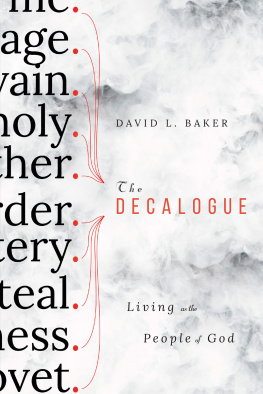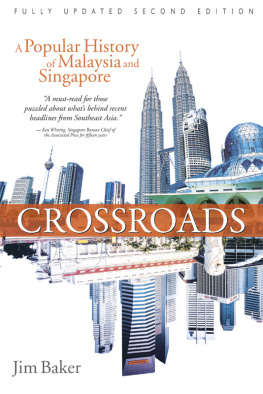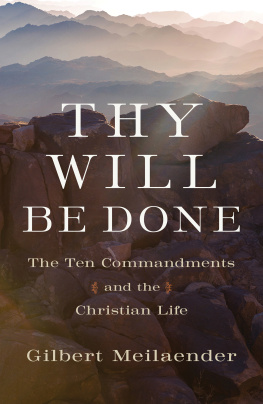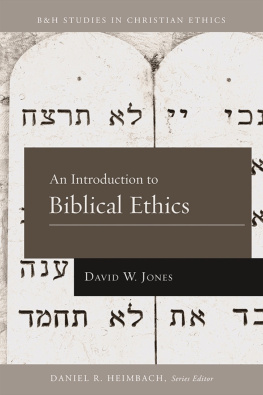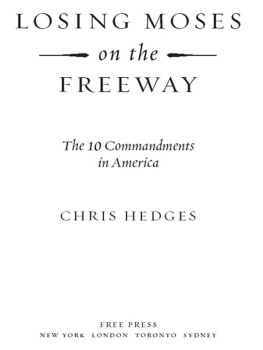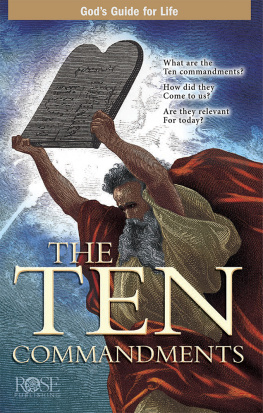The
DECALOGUE
Living as the People of God
DAVID L. BAKER
InterVarsity Press
P.O. Box 1400, Downers Grove, IL 60515-1426
ivpress.com
2017 by David L. Baker
All rights reserved. No part of this book may be reproduced in any form without written permission from InterVarsity Press.
InterVarsity Pressis the book-publishing division of InterVarsity Christian Fellowship/USA, a movement of students and faculty active on campus at hundreds of universities, colleges, and schools of nursing in the United States of America, and a member movement of the International Fellowship of Evangelical Students. For information about local and regional activities, visit intervarsity.org.
All Scripture quotations, unless otherwise indicated, are taken from THE HOLY BIBLE, NEW INTERNATIONAL VERSION, NIVCopyright 1973, 1978, 1984, 2011 by Biblica, Inc. Used by permission. All rights reserved worldwide.
Cover design: David Fassett
Interior design: Dan van Loon
Images: ozandogan/iStockphoto
ISBN 978-0-8308-8227-4 (digital)
ISBN 978-0-8308-5169-0 (print)
This digital document has been produced by Nord Compo.
For Meg, Abi, and Ivan
Three wonderful children!
PREFACE
For centuries it was taken for granted in the Western world that the Ten Commandments were relevant for all times and in all places. They were displayed on church walls and windows and formed an essential part of Roman Catholic and Protestant worship. The 1604 Anglican Canons decreed that the Ten Commandments be set up upon the East-end of every Church and Chapel where the people may best see and read the same (82). In Lutheran and Anglican liturgies today, the Ten Commandments or a summary of the law are read in preparation for confession, to convict people of sin so they turn to God for forgiveness. In some Reformed liturgies, they are placed after the confession of sin as guidance for Christian living. Either way, their continuing relevance for Christians is assumed.
But what about national and international ethics? In modern Western societies the relevance of the Ten Commandments is less obvious. Churches in Britain have been largely unsuccessful in opposing the liberalization of Sunday trading laws. In the United States there has been vigorous debate about whether the commandments should be displayed in schools and public places, and on several occasions judges have ruled that stone monuments inscribed with the commandments must be removed. While Christians may regret these outcomes, it is probably unrealistic to expect governments of countries that are becoming increasingly secularized to acknowledge the authority of biblical laws, though many of the principles they express are accepted by civilized peoples throughout the world.
In any case, I am convinced these laws are still important for the people of God, as I aim to show in this book. I tackle the commandments one by one in three contexts:
First, I place each commandment in the context of ancient Near Eastern law and culture. This context is mentioned only incidentally or not at all in most other books.
Second, I explain each commandment in the context of the Bible itself (canonical context). This has been done in other commentaries, but it is absolutely essential in my view and could not be omitted responsibly.
Third, I reflect on each commandment in the context of the world today. Many commentaries limit their scope to the biblical context, leaving readers to draw their own conclusions about the contemporary relevance of the text. There are also a good number of books with valuable insights concerning the relevance of the commandments, but these often lack a firm basis in the study of the text. I aim to bridge the gap by covering both explanation and reflection in one study.
The first part of the book introduces the Ten Commandments, including discussion of their shape and form, origin and purpose. Another matter that could have been included is reception history (how the text has been understood and used over the centuries), but this has been done well elsewhere, and to repeat it here would require a considerably longer book.
My hope is that this book will be useful for teachers and students, preachers and congregations, and all who are interested in understanding the original meaning and contemporary significance of this historic text. To make it accessible for as many readers as possible, I have minimized technical discussions in the body of the text, providing instead footnotes and bibliographies for the benefit of academic readers who wish to study things in more detail.
Finally, I am very grateful to family, friends, and colleagues who have supported and stimulated me during the years I have been writing about the Ten Commandments (or Decalogue, as they are often called by scholars). I began my research on Old Testament law when I was deputy warden at Tyndale House, Cambridge, and preached through the commandments at chapel there. The library resources and scholarly interaction at this unique center for biblical research were immensely important to me. Sabbatical leave granted by Trinity Theological College, Perth, enabled me to make further progress, and the work was completed after my return to Cambridge in 2014. Alan Millard, Abigail Patience, and Diana Hakala read various drafts and made many valuable suggestions. Finally, and most important of all, I mention my wife, Elizabeth. Not only has she read and edited the whole book, but she has also sustained and encouraged me unfailingly over the years. Thank you!
ABBREVIATIONS
BIBLE TEXTS AND TRANSLATIONS
BFBS | Hebrew Old Testament. London: British & Foreign Bible Society, 1958. |
BHQ | Biblia Hebraica Quinta. Stuttgart: Deutsche Bibelgesellschaft, 2004. |
BHS | Biblia Hebraica Stuttgartensia. 5th ed. Stuttgart: Deutsche Bibelgesellschaft, 1997. |
ESV | English Standard Version. Rev. ed. Wheaton, IL: Crossway, 2011. |
GNT | Good News Translation [Todays English Version]. 2nd ed.Philadelphia: American Bible Society, 1992. |
JB | The Jerusalem Bible. Garden City, NY: Darton, Longman & Todd, 1966. |
KJV | King James Version [Authorized Version]. 1611. |
Koren Bible | The Holy Scriptures. Jerusalem: Koren, 1983. |
LXX | Septuagint (ancient Greek translation of the Old Testament). |
MT | Masoretic Text (standard Hebrew text of the Old Testament). |
NET | New English Translation. Richardson, TX: Biblical Studies Foundation, 2004. |
NIV | New International Version. Updated ed. Colorado Springs: Biblica, 2011. |
NJB | New Jerusalem Bible. London: Darton, Longman & Todd, 1985. |
NJPS | New JPS Translation [Tanakh]. Philadelphia: Jewish Publication Society, 1985. |
NLT2 | New Living Translation. 2nd ed. Carol Stream, IL: Tyndale House, 2004. |
NRSV | New Revised Standard Version. New York: National Council of the Churches of Christ, 1989. |
REB | Revised English Bible. Oxford: Oxford University Press, 1989. |

